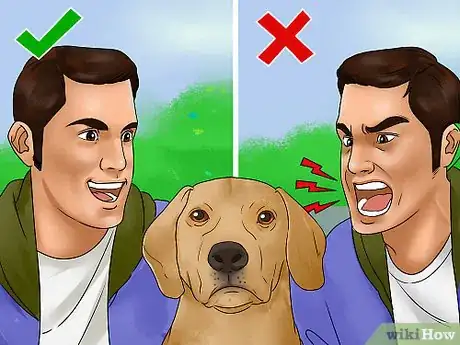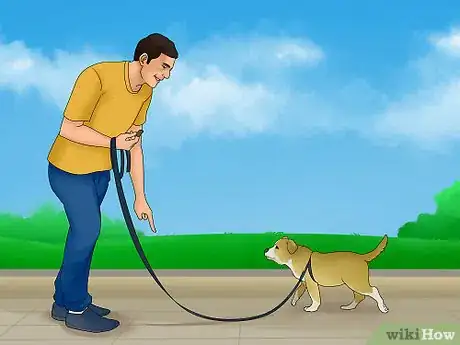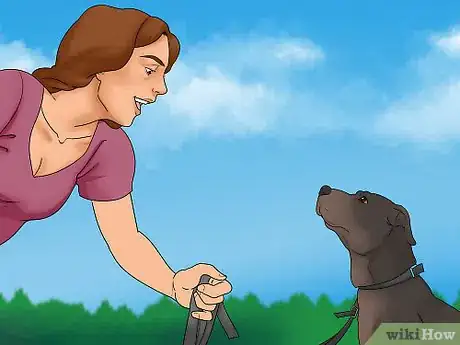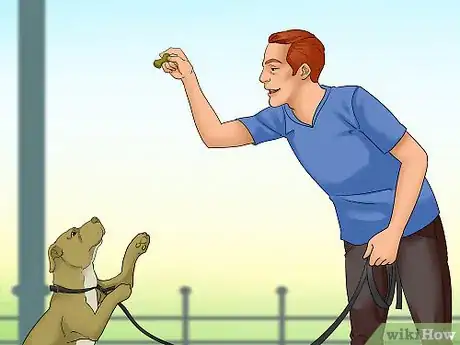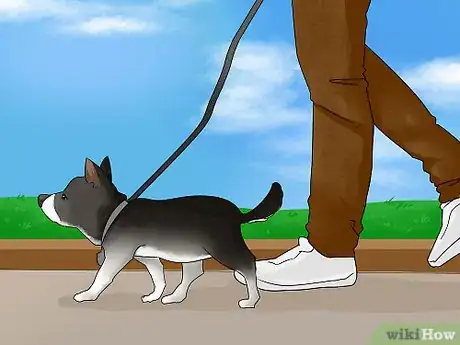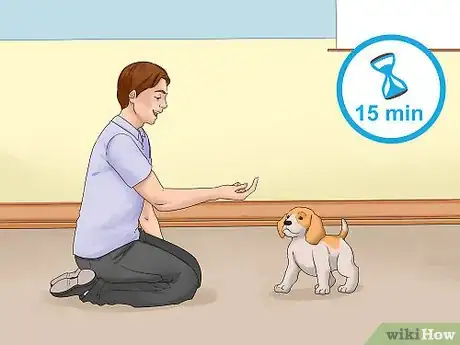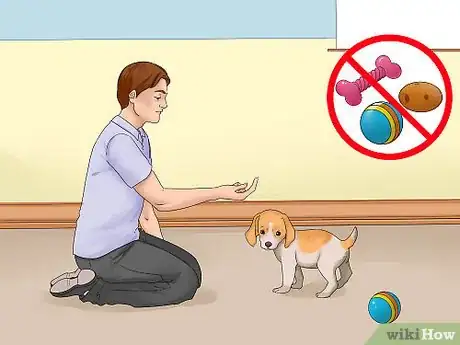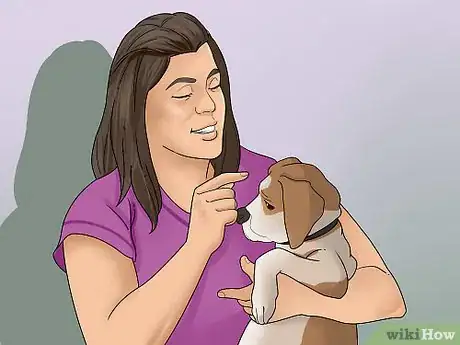This article was co-authored by Indigo Will. Indigo Will is a Canine Expert, Trainer, and Founder and Owner of K9-INDIGO® Holistic Dog Training LLC™, a dog training service in Los Angeles, California. Indigo specializes in understanding canine temperament and dispositions to allow canines to reach their full potential. He has studied various methods of training and philosophies to develop a unique, innovative, and result-driven method for canine behavior training.
There are 8 references cited in this article, which can be found at the bottom of the page.
This article has been viewed 17,807 times.
Getting a dog to listen can take some work, especially if the dog doesn't have much training. You need to make your expectations clear and teach your dog how to respond correctly to commands. It’s also important to help our dog focus by eliminating distractions and making your interactions fun. With some work and patience, you can get just about any dog to listen to you.
Steps
Using a Dog’s Name to Get Its Attention
-
1Say the dog’s name clearly. In order to get your dog to listen to you, it’s important that it knows you are talking to it. Using the dog’s name and saying it clearly so the dog can understand it will likely get its attention.[1]
- If your dog doesn’t know its name yet, work on that in training sessions. Getting a dog to learn its name will help with all future training.
-
2Use a kind tone. A dog is more likely to engage with you if you use a tone that shows it that you are not an aggressor. You do not need to be sugary sweet but you should not present as angry or displeased.
- Using anger and aggressiveness to deal with a dog’s misbehavior will only make the problem worse. Punishment is often misunderstood by dogs and it just makes them mistrust you.[2]
- Use an excited tone of voice with your dog. Your dog is more likely to engage with you if they think they’re missing out on something exciting.
Advertisement -
3Offer a treat when you say the dog’s name. If the dog is not coming when you say its name, you may need to encourage it with a treat. Get out a small training treat, available at all pet stores, and show it to the dog. When it comes to you after you say its name, give it the treat.[3]
- Use a treat consistently when you say the dog’s name until it comes right away every time you say its name. Then you can start to wean the dog off the treats and just give it a pet or say “good dog” to it when it comes to you.
Tip: Make sure the training treats you use are small and don't contain very many calories. Look for treats that are only 2-3 calories a piece. Using treats larger than that can cause you to overfeed your dog.
Teaching a Dog to Come When Called
-
1Pick a cue for when you want the dog to come. When teaching the come command, pick a specific word to use to signal your dog to come. Also decide on a hand movement that will be used in combination with the word and will only be used when you are asking the dog to come.[4]
- The word you use could be “come” but it could also be a different word, such as “here,” “now,” or any word you like.
- A hand gesture that is often used is to straighten your arm down by your side with your palm facing forward and then bend your arm straight up from the elbow.
Tip: Teach all of your family members, and anyone else who will be interacting with the dog on a regular basis, the cue and hand motion. This will help ensure that you are all being consistent and not confusing the dog.
-
2Keep the dog on a leash while doing initial training.[5] Having the dog on a leash will help you keep it focused. It also ensures that the dog is close enough to hear you and that you can move it to a location with less distraction if necessary.[6]
- Using a leash that has a long line works best. They allow the dog to get 15 or 20 feet away from you before you call them back.
-
3Give the cue and wait for your dog’s response. Say the cue and make your hand motion one time and then wait for a few seconds. You need to give the dog a few seconds to process what it heard before doing the cue again.[7]
- If the dog doesn’t show any sign that it heard you, you can do the cue again right away. However, it is likely that the dog is choosing to ignore you and you need to give it an incentive to come to you.
-
4
-
1Show the dog that it will get a treat as a reward if it listens to you.[11] When trying to get your dog to listen to you, you need to give it a reason to want to. Small dog training treats can be used during training to encourage your dog to do what you ask. Simply put a treat in your hand and raise it up so that the dog can see it. [12]
- If your dog is not excited about food, use something else that it’s excited about. You could pet it, play with it, or offer it a toy that it loves.
- Giving treats also reinforces the dog’s good behavior. The goal is to make the dog remember that it will get a treat when it does what you want it to do.
Helping Your Dog Focus
-
1Give your dog enough exercise.[13] When a dog has too much pent-up energy, it will have a hard time paying attention to you or to training sessions in general. Try to give your dog at least a half hour of exercise every day and if you are planning on doing a training session, do the exercise beforehand.[14]
- You don’t want your dog exhausted before training but you also don’t want it wild and crazy because it hasn’t done any physical activity all day. Try to be somewhere in the middle when training.
Tip: Exercise can come in a wide variety of forms. You could take your dog for a walk or jog around your neighborhood. You could go on a hike. You could play tug-o-war or fetch in your yard. Basically anything that gets your dog moving will help expend excess energy.
-
2Keep your training sessions short and interesting. Many dogs don’t have the ability to focus on training for long periods of time. This is especially true of young dogs and puppies. Aim to do training sessions that are about 15 minutes long and then play with your dog afterword. This will give the dog enough time to learn something but will also show it that training sessions are fun.[15]
- Vary your training sessions so your dog doesn’t get bored. This is especially important for highly intelligent and motivated breeds, such as retrievers.
-
3Eliminate distractions when training your dog. Some dogs don’t listen when they are distracted by exciting things around them, such as other dogs or toys they want to play with. If you are working on getting your dog to listen, do your initial training sessions without these distractions around.[16]
- To eliminate distractions, try to do training sessions in a private yard or in your home.
- Once your dog is responding to you reliably, introduce distractions into your training program. The goal should be to have your dog respond to you no matter what distractions are around.
-
4Be patient with your dog. You and your dog speak different languages, so clear communication can take some time to achieve. Remember this when your dog isn’t listening to you consistently. This will ensure that you have some compassion for your pet.
- The good news is that with some work and patience, you and your dog can figure out how to communicate.
Expert Q&A
-
QuestionHow do you get your dog to listen?
 Osama MaghawriOsama Maghawri is a Dog Trainer and Founder of OneStopK9, a dog training service in Miami, Florida. Osama utilizes balanced training methods to teach communication between owners and dogs. He specializes in basic obedience and behavioral issues such as resource guarding, fear-based aggression, and leash reactivity. Osama also helps owners understand the behaviors of their breed and how to continue training on their own in the future.
Osama MaghawriOsama Maghawri is a Dog Trainer and Founder of OneStopK9, a dog training service in Miami, Florida. Osama utilizes balanced training methods to teach communication between owners and dogs. He specializes in basic obedience and behavioral issues such as resource guarding, fear-based aggression, and leash reactivity. Osama also helps owners understand the behaviors of their breed and how to continue training on their own in the future.
Professional Dog Trainer I suggest you hand-feed your dog all of its meals. Doing this will help your dog engage with you more and focus better.
I suggest you hand-feed your dog all of its meals. Doing this will help your dog engage with you more and focus better.
References
- ↑ https://www.puplife.com/pages/how-to-teach-your-dog-to-recognize-their-name
- ↑ https://www.petplace.com/article/dogs/pet-behavior-training/how-to-teach-your-dog-to-come/
- ↑ https://www.whole-dog-journal.com/issues/11_12/features/Teaching-a-Reliable-Recall_16085-1.html
- ↑ https://www.whole-dog-journal.com/issues/11_12/features/Teaching-a-Reliable-Recall_16085-1.html
- ↑ Osama Maghawri. Professional Dog Trainer. Expert Interview. 9 September 2020.
- ↑ Indigo Will. Professional Canine Expert. Expert Interview. 8 September 2020.
- ↑ https://www.whole-dog-journal.com/issues/11_12/features/Teaching-a-Reliable-Recall_16085-1.html
- ↑ Osama Maghawri. Professional Dog Trainer. Expert Interview. 9 September 2020.
- ↑ https://www.petmd.com/dog/training/evr_dg_dos_and_donts_of_recall_training
- ↑ Osama Maghawri. Professional Dog Trainer. Expert Interview. 9 September 2020.
- ↑ Indigo Will. Professional Canine Expert. Expert Interview. 8 September 2020.
- ↑ https://www.petmd.com/dog/training/evr_dg_dos_and_donts_of_recall_training
- ↑ Indigo Will. Professional Canine Expert. Expert Interview. 8 September 2020.
- ↑ http://www.vetstreet.com/our-pet-experts/how-can-i-get-my-distracted-dog-to-pay-attention-to-me
- ↑ http://www.vetstreet.com/our-pet-experts/how-can-i-get-my-distracted-dog-to-pay-attention-to-me
- ↑ https://moderndogmagazine.com/articles/are-you-making-these-10-training-mistakes/29092

